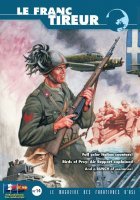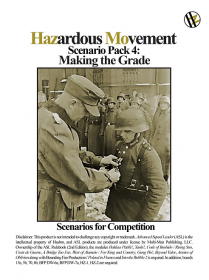Designed for the participants of the 2023 West Coast Rumble, these six scenarios are designed for minimum set up time, resulting in maximum playing time.
Q31 – Consthum, Belgium, 17 December 1944: In the unforgiving cold of December 17th, 1944, Consthum stood as an impregnable bastion. American defenders, fortified by the formidable 40mm Bofors anti-aircraft gun, had resolutely beaten back a series of relentless German onslaughts. Yet, as the chilling mist descended upon the battlefield, an unsettling hush pervaded, veiling the imminent confrontation in an enigma. Emerging from the spectral mist, silhouettes of cloaked figures materialized: one, three, seven, fifteen, and more, advancing steadily. American GIs raised their weapons, fingers trembling on triggers, poised for the impending clash.
Q32 – North of San Leonardo, Italy, 10 December 1943: In the early hours, the Loyal Edmonton Regiment, backed by tanks from The Calgary Regiment and a machine-gun platoon from the Saskatoon Light Infantry, embarked on their northward advance. Their objective: to secure the crucial Cider Crossroads, where the San Leonardo-Tollo Road intersected with the Ortona-Orsogna highway. However, as they made their way through the apparently abandoned countryside, they soon found themselves confronting formidable German resistance. Waves of concentrated machine-gun and mortar fire rained down upon them, proving immune to the efforts of even their own artillery. Undaunted, the Loyal Eddies pressed forward, determined to overcome this fierce opposition and achieve their mission.
Q33 – Mondrainville, France 28 June 1944: Kampfgruppe Weidinger, a unit from the formidable 2nd SS-Panzer Division Das Reich, exhibited tactical prowess by circumventing the forward positions held by the 7th Seaforth Highlanders at Le Valtru. This strategic maneuver enabled them to exploit the gap in the defensive line and continue their eastward push toward Mondrainville. As the German vanguard pressed ahead, various British units scrambled to hastily establish defensive positions, aiming to delay the advancing German forces for as long as possible.
Q34 – Isneauville, France, 8 June 1940: The German 5th and 7th Panzer Divisions exploited a rift in the French 10th Army's line. Despite Allied efforts along the Andelle River, their defenses crumbled, revealing a glaring vulnerability. In the early hours of June 8th, the German 5th Panzer Division launched its attack, swiftly overwhelming British positions and plunging the battlefield into chaos. By approximately 1600 hours, the lead German units encountered a determined British blocking position six kilometers north of Rouen. Major Syme, leading a makeshift unit comprised of Territorial Army troops, put up a valiant rear-guard fight.
Q35 – West of Gremjachi, Russia, 12 December 1942: Operation Wintergewitter aimed to relieve the besieged Sixth Army in Stalingrad under General Friedrich Paulus. With limited reserves, the 6th Panzer Division played a pivotal role after arriving from France. Following Operation Uranus, which encircled the Sixth Army, the Red Army consolidated its gains in the Stalingrad Pocket. The German High Command sought a quick breakthrough, capitalizing on the element of surprise.
Q36 – Haute Littee Crossroads, France, 11 June 1944: Trévières fell to American forces by 0845 hours, and the US 2nd Infantry Division pursued the retreating Germans by moving southward. Surprisingly, they faced minimal opposition, allowing them to push all the way to Cerisy Forest. The forest itself was surprisingly lightly defended by the Germans. The 9th Infantry Regiment encountered weak resistance as they traversed the forest en route to Balleroy to the east. On the evening of that day, the 1st Battalion of the 9th Infantry Regiment continued their advance to seize the Haute Littee crossroads at the forest's southwestern edge. Their progress was impeded by the Engineer Battalion of the German 352nd Infantry Division, entrenched around the crossroads.











